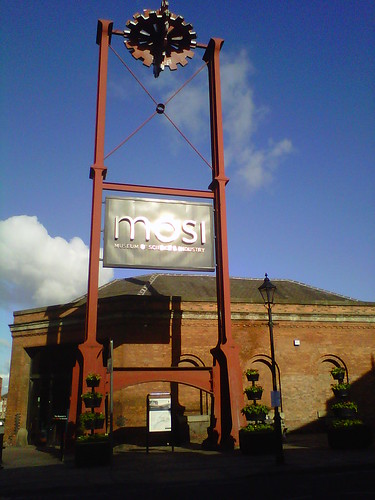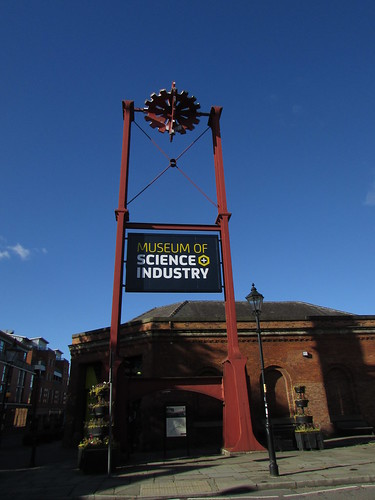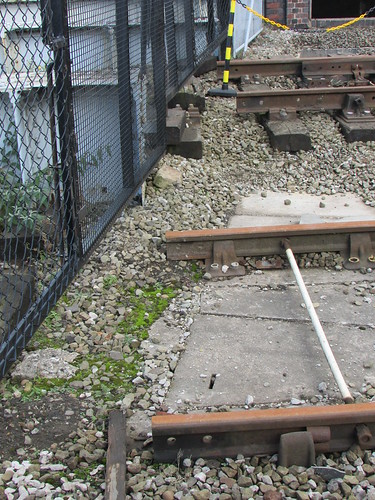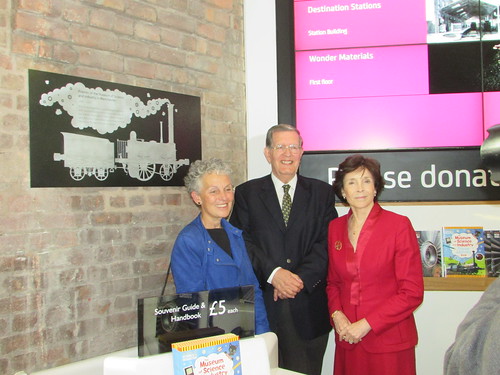The first main-line railway in the world was the Liverpool and Manchester Railway, opened in 1830. The Manchester terminus was situated in Liverpool Road and the immediate success of the Liverpool & Manchester Railway resulted in passenger traffic outgrowing the site by 1844, moving to a larger station at Manchester Victoria which offered interchange facilities with other railways which were springing up. The original Liverpool Road site was retained as a Goods Depot which remained in use until 1975. There's a brief history of the site on the excellent 'Disused Stations' site here. The group of buildings and structures which survive offer a remarkable insight into the start of the Railway Age. The term "World Heritage Site" has often been used in describing the area but, tragically, it was not formally so designated and relied on the protection offered, latterly, by the Planning (Listed Buildings and Conservation Areas) Act 1990.
A Science Museum for Manchester
In the 1960s, there was widespread support or the idea of creating a science and technology museum in Manchester and Dr. Richard Hills M.B.E. was involved in the creation of the North Western Museum of Science and Industry, becoming a Curator/Director in 1965. The museum found temporary accommodation in 1967 at 97 Grosvenor Street which had been purchased for redevelopment by the University of Manchester Institute of Science and Technology (UMIST) but the larger objects being acquired by Dr. Hills for the museum had to be dismantled and placed in store until a permanent home could be found.
The Liverpool Road Station Society
A group of mainly local people formed the Liverpool Road Station Society and adopted these aims in 1979:-
The preservation and restoration to its original condition of Liverpool Road Railway Station in the City of Manchester as a place of historical interest with the outbuildings and appurtenances thereto belonging in such manner as shall be thought fit and in furtherance of these objects but not further or otherwise the Society shall have the following powers: To promote public interest in the Society's celebration of the 150th anniversary of the inauguration in 1830 of of the Liverpool and Manchester Railway and for celebrating of the anniversary in succeeding years.Two aims converge
Greater Manchester Council eventually purchased the Liverpool Road site to provide a permanent home for the Science Museum and this allowed the Liverpool Road Station Society to organise a gala at the site in 1980, the same year that a locomotive cavalcade, 'Rocket 150', was held at Rainhill to celebrate the 150th anniversary of "Rocket's" success at the Rainhill Trials. There's an interesting piece on the acquisition of the Liverpool Road site in the blog of the Centre for the History of Science, Technology & Medicine here.
The Museum of Science and Industry
The Greater Manchester Museum of Science and Industry opened to the public on 15th September 1983. In 1985 the 'Friends of the Greater Manchester Museum of Science and Industry' charity replaced the 'Liverpool Road Station Society' to both continue its work in preserving the railway aspects of the site and also provide volunteers to assist the professional staff in the various museum galleries. Also in 1985, the museum took over the museum established in the former Lower Campfield Market which became the Air and Space Hall.
A short demonstration railway line was created through the museum yard and the Friends operated steam trains on Saturdays, Sundays and Bank Holidays, giving the public round trips from a station near Lower Byrom Street to the museum railway gates adjacent to Water Street. From here, the original connection to the main line was retained, allowing occasional visiting locomotives. The site had two resident locomotives - 'Agecroft No. 3', an RSH 0-4-0ST and 'Lord Ashfield', a Barclay six-coupled Fireless Steam. Passengers were carried in a pair of 4-wheel vehicles built to resemble typical 1830 coaches which were roofed but open-sided. A modest charge was collected by the Friends with the ambitious aim of funding a working replica of an 1830-era locomotive.
At that time, the museum itself operated as a charitable trust under the name 'The Greater Manchester Museum of Science and industry' (sometimes referred to simply as 'GMMSI') which was also its 'working name'. However, the Greater Manchester County Council was abolished on 31st March 1986 so, later, the 'working name' was changed to the 'Museum of Science and Industry in Manchester' ('MSIM') and, similarly, the Friends Organisation became known as 'Friends of the Museum of Science and Industry in Manchester' with the aim of "supporting the Museum of Science and Industry in Manchester by providing volunteers and financial donations". At that time, all working volunteers were required to be members of the Friends organisation. At some point, I think the museum became known as 'Manchester Museum of Science & Industry' ('MMSI')
The visit of 'Lion'
In the post Lion I described how I became involved with the locomotive 'Lion' during her tour in 1988. As a result, I accompanied 'Lion' to Manchester for a series of very successful steamings in 1988.
Jan and the Museum of Science and History
I found the volunteers at Manchester very welcoming. I shared their affection for the unique location and became a member of the Friends, beginning a long career as a working volunteer on the museum's steam railway. I've been a witness to the various changes at the museum since 1988 but not, I'm afraid, an assiduous chronicler. I didn't become a 'blogger' until the end of 2006 (with a tentative initial post titled In the beginning .... There are a number of posts describing my involvement with the museum both before and after that date but it is a very patchy record I'm afraid. You can find them all by selecting the label 'MOSI', clicking here or select individual posts from the list in the section Related posts on this website below.
As a working volunteer at the museum, I was involved with the operation of the steam train rides, progressing through the ranks of guard, shunter, fireman, driver and operating officer. At first, we used the locomotives 'Agecroft No. 3' and 'Lord Ashfield'. From time-to-time there were other visiting industrial locomotives. I was involved in arranging the visit of the 0-6-0 well tank 'Bellerophon' dating from 1874 and was appointed "owner's representative" during the visit. Because of my involvement with 'Lion', I'd also become a working volunteer at Birmingham Railway Museum (there's a brief description here) so I was gaining practical experience at two, albeit short, railways. I'm uncertain about the chronology, but I was delighted when Manchester obtained permission to run the regular trains beyond the museum railway gates. The extended running line took passengers across the Water Street bridge, the listed Irwell Bridge built by the Stephensons in 1830 and into Salford, stopping at a second set of gates beyond which we had a tantalising view of the connection to the parallel main line. On the extension, we could watch the passing trains and they could watch us. Waving and whistling was usual. Further changes to the railway were to follow.
The museum and the 'Planet' replica
As early as 1984, Doctor Richard Hills, talking about the replica 1830 coaches, said "One day, if finances allow, the dream might be realised of building a replica locomotive of the same period to go with the coaches". Led by Michael Bailey, and with additional sponsorship from British Engine Insurance, the Friends organisation succeeded in designing and building a working replica of the 1830 'Planet' locomotive. The replica was inaugurated in 1992. I participated in 'trials' carried out by 'Planet' at two preserved railways - the Great Central Railway and the East Lancashire Railway. After the excitement of the 'trials', 'Planet' settled into the role of bearing the brunt of operating the regular passenger rides. There's a short review of the history of the replica in the post from 2013 here.
Changing times
The museum continued to develop. The regular use of 'Planet' and the extension of the running line over the Irwell Bridge brought increased interest in the railway but, sadly, when heavy repairs to both 'Agecroft No. 3' and 'Lord Ashfield' were required, funds could not be found for either. I regretted this: 'Agecroft No. 3' was the first locomotive I drove on a regular basis and the use of a fireless steam locomotive on a passenger service was unusual, if not unique.
During the 1990s, the museum seemed to lose its pride in its local connections and a re-branding exercise replaced the old-fashioned 'MSIM' (or was it 'MMSI'?) with the inelegant 'MOSI' - 'Museum Of Science & Industry'. Ostensibly to improve site car parking arrangements, some time in the 1990s, the original platform near Lower Byrom Street was abandoned and a new rather inconvenient platform substituted further down the site. At some stage, the shorter run was more than compensated by the laying of a new line across the top of the Colonnade which joined the original line at the Irwell Bridge, forming a 'Y' shaped route and adding interest for the public in being able to watch the fireman operate the ground frame which controlled the junction points.
'Riot of Steam'
In 2005, the Museum improved the railway facilities by constructing a loop and siding in the vicinity of the 1830 Warehouse, in time to mount a major event called 'Riot of Steam' to commemorate the 175th anniversary of the opening of the Liverpool and Manchester Railway. I enjoyed this event, managing to get brief periods driving on the visiting 'Rocket', 'Sans Pareil' and 'Novelty' replicas, in addition to a 'turn' on 'Planet'. The locomotive 'Lion' was in store in the Power Hall at the time (in non-steamable condition) and, with special permission from the owners Liverpool Museums, was dragged into the sunlight. Unfortunately, the event was not a financial success. Remarkably, 'Riot of Steam' has failed to provoke its own blog post here (as yet) but there is a collection of my pictures called Liverpool & Manchester 175th.
Transport Festival, August 2009
The museum re-instated the running line to its original length by using the remaining siding adjacent to the Power Hall (with the all-important inspection pit) as the new running line and providing a new single platform, ready for a nine-day Transport Festival hosted by the museum in August 2009, the last three days of which carried the sub-title the 'Great Garratt Gathering'. My report is here.
Liverpool & Manchester 180th Celebrations
In September 2010 the 180th anniversary of the opening of the Liverpool and Manchester Railway was celebrated at various locations. At the museum, the 'Planet' replica was joined by the 'Rocket' replica (with its own train). As well as working on 'Planet', I was able to renew my acquaintance with 'Rocket'.
More changing times
Although 'Agecroft No. 3' had been transferred to Swindon Museum, with renewed optimism sister engine 'Agecroft No. 1' was acquired (in kit form) and, with support from the Friends, was restored and returned to service in 2011. The museum ran 'Thomas the Tank' events in 2011 and 2012.
MOSI and the Science Museum Group
Amidst increasing austerity, MOSI became part of the Science Museum Group in February 2012. This did not end the financial problems and, in 2013 the Director of Science Museum Group Ian Blatchford said that the further cut in funding proposed by the government would result in one of the northern museums closing, as I reported here. My report also discussed the threat to the museum's extended demonstration line posed by Network Rail's Ordsall Chord scheme. In my later report here in October 2013, I reported that the threat of museum closure had abated, but that a number of paid staff had lost their jobs and that, although the Museum had formally registered objections to the Network Rail proposals, that threat was undiminished.
Happy Birthday 'Planet'
In 2013, the 'Planet' replica was 21 years old and, amid the gathering gloom, a party was held at the museum on 27th November 2013 (report here). When I later heard that the museum had withdrawn their formal objections to the Network Rail plans in return for financial compensation, I think I despaired and subsequently stopped volunteering in circumstances that I would not have chosen.
Spot the difference
Clearly, a little more rebranding was called for. The unloved 'Museum Of Science & Industry' was swept away.

Museum of Science & Industry: The 'Ferranti Tower' in 2012.
The altogether more accessible form 'Museum of Science + Industry' came into use. The '+' sign presumably represents the 'science' part of the brief. Visible on the picture (but not available on a simple 'QWERTY' keyboard, I'm afraid) is the hexagon and circle placed co-axially with the '+' sign. I assume the hexagon and circle form a 'nut' representing the 'industry' side of the brief.

Museum of Science + Industry: The 'Ferranti Tower' in 2016.
Demise of the Friends
The 'Museum of Science + Industry', of course, carries on as part of the Science Museum Group but the museum which the Friends organisation was set up to help no longer exists so the Friends organisation is now disbanded after some 31 years and has disbursed its remaining funds to the 'Museum of Science + Industry' to be used on a number of nominated projects, after which it will be removed from the charities register and will cease to exist. Although the 'Friends' are no more, the Museum is seeking 'Volunteers' - more information here. As far as the railway operation is concerned, there is a role 'Trainee Railway Fireman', described here although I believe paid staff are also used on the operation which still intends to offer passenger rides. The railway 'extension' and the line over the colonnade are no more. The demonsration line is now truncated at the Water Street Railway gate, exactly as it was back in 1988 when I became a Friend.

Museum of Science + Industry: Disconnected tracks at the gates of the Museum.
Commemorating the contribution of the Friends
I received an invitation to attend the unveiling of a commemorative plaque in honour of the Friends of the Museum on 19th October 2016. I attended the well-patronised event, specifically hoping to see some of the many railway operating volunteers I'd enjoyed working with over more than a quarter of a century. I think I counted four. The plaque reads:-
Friends of the Museum of Science and Industry in Manchester 1983-2015My pictures of the event are here.
The museum gratefully acknowledges the time, work and fundraising of the many members of the Friends organisation. Their tireless support and dedication helped us achieve our high reputation for learning and enjoyment.

Museum of Science + Industry: Commemorate plaque and (L-R) Sally MacDonald (Museum Director), Michael Bailey, Dame Mary Archer DBE (Chairman of the Board of Trustees).
Related posts on other websites
Liverpool Road (Transport Heritage site)
Liverpool Road (Wikipedia)
Related posts on this website
Dates are original posting dates, not dates of events described.
'Single-Wheeler' locomotives 10-Nov-2015
Driving the 'Planet' replica 11-Sep-2015
Happy Birthday 'Planet'! 29-Nov-2013
'Planet' in Perspective 12-Nov-2013
'Planet' at MOSI - The First 21 Years 21-Oct-2013
Another Saturday in Manchester 12-Oct-2013
The Planet Replica 10-Oct-2013
Manchester Mini Maker Faire 2013 13-Aug-2013
A Busy Week 5-Aug-2013
A Saturday in Manchester 11-Jun-2013
Easter Week at the Museum of Science and Industry 9-Apr-2013
Saturday Steam 4-Mar-2013
Santa Specials - 2012 17-Dec-2012
Day out with Thomas at MOSI 31-Aug-2012
MOSI Mini Maker Faire 15-Aug-2012
Agecroft at MOSI 3-Jan-2012
'Thomas' visits MOSI 4-Sep-2011
Agecroft No. 1 2-Jun-2011
Liverpool & Manchester 180th Celebrations 30-Sep-2010
Beyer Peacock, Gorton 28-Sep-2010
Transport Festival, August 2009 16-Aug-2009
New Platform at MOSI 30-Jun-2009
Dalek Invasion in Manchester 26-Aug-2007
Museum of Science and Industry in Manchester 26-Aug-2007
'Planet' locomotive in Operation 14-Apr-2007
My pictures
All my albums around the museum are here.
[L&M 180th Celebrations added 29-Oct-2016]
